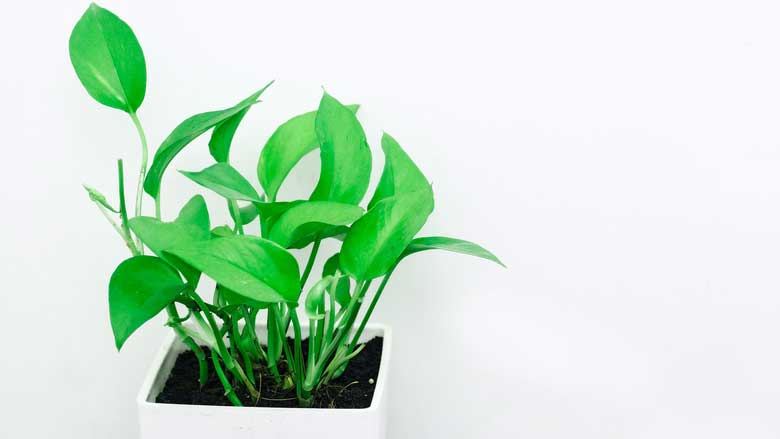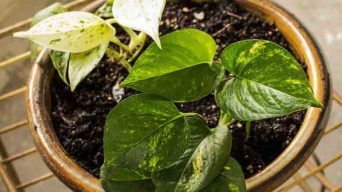Water your Pothos every 1-2 weeks, allowing the top inch of soil to dry. The frequency is influenced by light, temperature, humidity, pot size, and soil type. Adjust your watering routine to seasonal changes, increasing frequency in warmer months and reducing it in winter. Ensure the soil is thoroughly soaked during watering and allow it to dry between sessions. While Pothos can endure 2-3 weeks without water, a general guideline is to water them weekly for optimal well-being.
The Pothos plant (Epipremnum aureum), also known as Devil’s Ivy, stands out as an ideal choice for those seeking a fast-growing and effortlessly manageable houseplant. This indoor greenery excels in low-maintenance care, thriving with minimal attention.
Even in low light conditions or when exposed indirectly to sunlight, Pothos exhibits robust growth, catering perfectly to individuals lacking a green thumb or constant access to natural light.
However, mastering the art of caring for this plant hinges significantly on a crucial aspect: watering. This article provides a comprehensive guide on how often should you water a Pothos plant and offers insights into recognizing signs of thirst in your plants.
How Often To Water Pothos Plants?
Water your pothos plants every one to two weeks for optimal care. Ensure the top inch or two of the soil has dried out before watering.
The frequency of watering your pothos, however, is contingent on several factors. These include the pot’s size, the type of potting mix used, and the prevailing temperature conditions. These variables are crucial in determining the ideal watering schedule for your pothos.
Factors Affecting Pothos Watering Schedule
Several factors influence the watering frequency for pothos plants. Among these, the level of light exposure holds significant sway over the plant’s water requirements.
Consider the following aspects when determining your watering routine:
1. Temperature’s Impact on Watering
The temperature in your living or working space directly impacts how often you should water pothos. Warmer environments lead to quicker soil drying, necessitating more to be watered more often. Conversely, cooler temperatures reduce the plant’s water needs. The ideal temperature range for pothos plants is 70 to 90 degrees Fahrenheit. Any deviation from this range will affect your watering frequency.
In summary, pothos plants generally require more water in warmer temperatures and less in cooler conditions. The same principle applies to light exposure; more light usually means increased water needs.
2. Considering Humidity Levels
Humidity is another factor influencing how often should you water pothos plants. Dry air accelerates moisture loss, prompting more frequent watering, while humid conditions reduce the need for regular watering. Watering pothos once a week or two may suffice if you reside in a high-humidity area. In contrast, low-humidity locations may require watering every three or four days.
To address low humidity, consider using a humidifier or misting the plant’s leaves. However, be cautious not to over-mist, as excessive moisture can cause yellowing of pothos leaves.
3. The Role of Light Conditions in Pothos Watering
The amount and intensity of light significantly affect a pothos plant’s water needs. Bright, direct sunlight increases evaporation needs to be watered more often than low-light conditions. The duration of daily sunlight exposure and seasonal variations also play a role. Longer exposure and brighter seasons often demand more frequent watering.
Achieving a balance in light exposure is crucial. Monitor soil moisture and overall plant health to adjust your watering schedule based on lighting conditions.
4. Soil Type’s Influence on Watering Needs
The type of soil used impacts watering frequency. Well-draining soil, with perlite as a primary ingredient, dries out faster, requiring more frequent watering. Conversely, slow-draining soil retains moisture, reducing the need for frequent watering. Adjusting perlite levels can influence drainage.
Assess your pot’s drainage by observing water drainage time. Quick drainage (within minutes) indicates good drainage, while slow drainage (an hour or more) suggests poor drainage, requiring adjustments or repotting.
5. Choosing the Right Pot Size
Watering frequency is influenced by the size of the pot. Smaller pots tend to dry out more quickly, which means they need to be watered more often. Conversely, larger pots retain moisture for longer periods, requiring less frequent watering. Also, consider the pot material; porous materials dry out faster than non-porous ones.
Evaluate pot size in relation to soil volume and plant type, especially for pothos with trailing foliage. For instance, plants in clay pots may need more frequent watering than those in plastic pots due to differing moisture retention properties.
Adapting Your Pothos Watering Routine to Seasonal Changes
To maintain optimal health for your pothos plant, it’s crucial to adapt your watering routine based on the changing seasons. Increase the watering frequency during spring and summer while reducing it in fall and winter.
In the warmer months, ensuring sufficient humidity for your pothos is vital. If the air is too dry, the leaves may turn brown and fall off. Consider misting the plant every few days to boost moisture or placing it on a water-filled pebble tray. Alternatively, relocate it to a more humid environment like your bathroom or kitchen.
Scale back your watering frequency as winter sets in with cooler temperatures and shorter days. Aim to water your pothos every two to three weeks or when the top inch of soil feels dry. Always check the soil before watering, as overwatering is a common cause of plant demise.
In winter, particularly in dry climates or heated homes, monitor your plant closely. If leaves are yellow or droop, it’s a clear signal that your pothos require more water. Keep a vigilant eye on your plant’s condition to ensure it thrives throughout the changing seasons.
Watering Your Indoor and Outdoor Pothos
Maintaining optimal humidity levels is crucial when caring for your indoor pothos plant. These plants thrive in humid environments, so more frequent watering may be necessary in drier home conditions. Monitor indoor heat levels, as warmer conditions may require increased watering.
Use a watering can with a long spout for houseplants to ensure water doesn’t touch the leaves, preventing yellowing or rot. Pour water slowly and evenly over the soil, allowing it to run through the drainage holes to avoid overwatering. Afterward, empty any collected water from the pot’s saucer to balance hydration and avoiding waterlogged roots.
Outdoor pothos care requires attention to local weather conditions. During heavy rain, watering may be unnecessary, as natural moisture is sufficient. Conversely, in drought or heatwaves, more frequent watering is essential. Regularly check the soil and water when the top inch feels dry.
Understanding the specific heat tolerance of your pothos species is vital for proper care. Use a hose with a sprinkler attachment for outdoor watering to shield leaves from direct contact, preserving their vibrant quality and preventing yellowing or rot. Focus on watering the soil, not the leaves, to discourage fungal growth associated with wet leaves.
Whether indoors or outdoors, striking the right balance in watering practices is key to maintaining the health and vibrancy of your pothos.
Determining When to Water a Pothos Plant
Pothos plants, renowned for their resilience, can adapt to diverse conditions. However, despite their hardiness, proper watering is essential for their well-being. Each pothos species has specific watering requirements, so the general guideline may vary based on your plant’s variety.
Understanding the ideal watering frequency is vital for maintaining the overall health of your pothos. Attending to its needs with precision ensures the lush vines of your plant will thrive.
Several methods can help you discern when to water your pothos, tailored to its specific species or variety.
Start by assessing the moisture level in the potting soil. Remember, the key is to water when the soil is dry rather than adhering to a fixed schedule.
A moisture meter offers another effective way to gauge your pothos’ water requirements. When inserted into the potting soil, these devices provide accurate readings of moisture levels, making them valuable tools for all pothos varieties.
Observing the leaves can also provide valuable insights into your pothos’ water needs. Wilting or drooping vines signal a need for additional watering.
Furthermore, yellowing or browning leaves across various pothos varieties indicate that your houseplant requires watering regardless of its species.
It’s important to note that overwatering and underwatering are common challenges with pothos plants. Striking a balance between the two is crucial for maintaining your plant’s attractive vines and overall health, irrespective of its variety.
Signs of Overwatering
Overwatering is a common issue affecting pothos plants. Recognizing signs of overwatering is crucial for maintaining the health of your pothos. Here are key indicators to watch for:
- Yellowing leaves: The initial sign of overwatering is often yellow leaves. If you observe this, reduce the watering frequency promptly.
- Mushy or soft leaves: Overwatering can lead to mushy or soft leaves, indicating root rot. Taking immediate action is essential to save the plant.
- Mold or mildew: The presence of mold or mildew indicates overwatering. Swift action is crucial, as these issues can harm your plant.
- Soggy soil: Overwatering often results in waterlogged soil. Consistently wet soil signals excessive watering.
- Pest problems: Overwatering attracts pests like root mealybugs, which feed on plant nutrients. Timely intervention is necessary to prevent these pests from becoming fatal to your houseplant.
To address overwatering, allow the pothos to dry out completely. This eliminates mold or mildew, giving the pothos roots a chance to recover. After drying out, resume watering but reduce the frequency.
Signs of Underwatering
Pothos plants, a resilient aroid species, can endure periods without water. Nevertheless, regular watering promotes faster growth. Look out for these signs of underwatering:
- Drooping leaves: The first sign of underwatering is drooping leaves. If you observe this, it’s time to give your plant a drink.
- Dry, crispy leaves: Underwatering can result in dry, crisp leaves, indicating insufficient water supply.
- Brown leaves: Brown leaves signal underwatering. While excessive sun or wind can cause browning, underwatering is also a potential cause.
- Slow growth: Insufficient water may lead to slow plant growth.
When these signs appear, increase your pothos watering frequency. Water immediately and check the soil after a few hours. If the soil remains dry, provide more water until it is evenly moistened, allowing water to drip from the pot’s drainage holes.
How Much Water Does a Pothos Plant Need?
Pothos plants, known for their resilience to drought, can thrive for weeks without water. However, consistent watering accelerates their growth. The most effective approach is to allow the soil to completely dry out between waterings.
When hydrating your pothos, provide a thorough soaking, ensuring the soil becomes saturated and water starts to emerge from the drainage holes. Once saturated, allow excess water to drain away, refraining from additional watering until the soil has dried out.
This watering technique promotes deep root growth, a crucial element for the plant’s overall health. Additionally, it serves as a preventive measure against issues such as root rot and the development of yellow or brown leaves caused by excessive or insufficient water.
How Long Can Pothos Go Without Being Watered?
Pothos plants exhibit impressive drought tolerance, capable of enduring weeks without water. Ideally, you should allow the soil to thoroughly dry out between waterings, enabling your pothos to sustain itself for 2 to 3 weeks. Exceeding this duration, however, may adversely affect their well-being.
While pothos plants are robust and can endure a degree of neglect, sustained inattention will hinder their thriving. Striking a harmonious balance between watering and soil drying is crucial. Maintaining this equilibrium ensures the longevity of your pothos plant’s happiness and health over the years.
Typically, a weekly watering suffices for optimal health. Nevertheless, under suitable conditions, pothos plants can extend this interval without detriment.
Final Thoughts
Pothos plants are an ideal choice for novice plant enthusiasts due to their low maintenance requirements. To ensure optimal care, water your pothos weekly; however, it’s advisable to check the soil moisture beforehand. Water the plant thoroughly until water freely drains from the bottom of the pot, allowing it to drain completely before returning it to its designated spot.
Maintaining a healthy pothos plant is straightforward, so there’s no need to complicate the process. Armed with fundamental knowledge and a bit of attention, your houseplant is poised to flourish, providing you with years of satisfaction.







